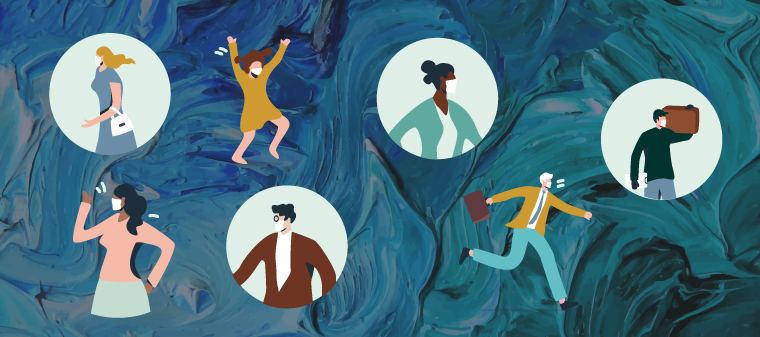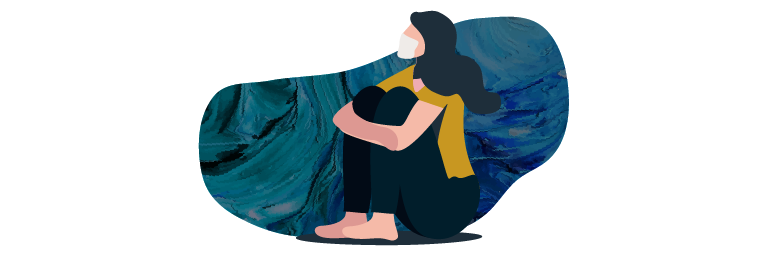How Communities Can Prevent Panic in Uncertain Times

As COVID-19 spread across the globe, panic around the pandemic proliferated, too. Shoppers cleared shelves of toilet paper; surgical masks went out of stock; and hand sanitizer was nowhere to be found.
Like disease, panic is a social contagion that can sweep whole populations into a frenzy, adding mental health complications to a public health crisis like a pandemic. Entire communities feel compelled to engage in behaviors they see others around them doing, particularly during a crisis; participating in activities like panic-buying can provide a sense of control when people feel surrounded by chaos.
But there are strategies people can use to calm their personal panic levels and dispel panic in their communities.
“Panic goes in herds,” Jantz said. “Decide: Am I going to be a part of that?”
How Does Uncertainty Affect Anxiety in a Crisis?
Feeling some level of stress or anxiety is healthy in a crisis because it helps individuals protect themselves.
“A component of this stress response is activating your body and your mind to mobilize for a threat,” said Dana Rose Garfin, an assistant adjunct professor at the University of California, Irvine. “You do want some of that stress response activated so you are motivated. However, you don’t want the stress to be at such a high level that it causes physical and mental health problems over time.”
Too much stress can manifest in unhealthy ways, such as interrupting sleep, hindering daily tasks or interfering with concentration. Stress and anxiety that are persistent, pervasive and prevent people from basic functioning become worrisome, said Bethany Teachman, a licensed clinical psychologist and psychology professor at the University of Virginia.
“Watch for a pattern of really catastrophic thinking, or assuming the worst when [you] don’t have full information,” Teachman said. “When all of those factors are occurring, that’s a sign that they’re really moving into that realm of unhealthy stress management.”
What Are the Mental Stages of a Crisis?

Uncertainty
Uncertainty is particularly prevalent at the beginning of a crisis when there are more questions than answers.

Fear, anxiety and dread
Fear can help motivate people to take action. Alternatively, fear of the unknown can also be debilitating and prevent people from taking action.

Hopelessness and helplessness
Hopelessness is the feeling that nothing can be done to make a situation better while helplessness is the feeling that people have no power to improve their situation or protect themselves. These feelings can arise when fear, anxiety and dread go unchecked.

Denial
Denial is refusing to acknowledge harm that has occurred or will occur. People enter denial when they do not have enough information, assume a situation is not dangerous, do not understand how to respond to a threat or behave as if they are not in danger.
The uncertainty of a crisis can compound feelings of stress and anxiety during situations like lasting pandemics. According to research in Nature Reviews Neuroscience, uncertainty causes anxiety because it disrupts our ability to predict and avoid the potential negative impacts of future threats.
“The ability to use past experiences and information about our current state and environment to predict the future allows us to increase the odds of desired outcomes, while avoiding or bracing ourselves for future adversity,” Dan W. Grupe and Jack B. Nitschke wrote in their journal article, “Uncertainty and Anticipation in Anxiety.” “This ability is directly related to our level of certainty regarding future events – how likely they are, when they will occur, and what they will be like. Uncertainty diminishes how efficiently and effectively we can prepare for the future, and thus contributes to anxiety.”
But as Teachman noted, individuals can reframe uncertainty by reminding themselves that they cope with it all the time in small ways, such as uncertainty around job applications, dating new people or testing unfamiliar recipes.
“We actually have had lots of practice at this, which tells us that we can do it even though it’s hard,” Teachman said.
Building tolerance for uncertainty and uncomfortable situations can help people manage anxiety.
“It is uncertain, and knowing that, there’s a certain amount of certainty,” said psychologist Mary Alvord, director of the Maryland psychotherapy practice Alvord, Baker & Associates, LLC. “Learning to be comfortable with some distress is very important for our mental health.
Knowing a crisis will come to an end – even if the time line is undefined – helps, too.
“It may take quite a while but it’s not forever,” Alvord said. “Tolerating change and kind of looking at life with more cognitive flexibility helps us all.”
How to Manage Fear and Anxiety in Uncertain Times
Although unknown factors can increase feelings of panic, relying on what you know to be true, focusing on factors in your control and using other calming interventions can provide a sense of empowerment during public health crises and keep panic levels in check.

1
Focus on what you can control.
Create a plan of attack to take positive steps toward controlling the factors you can. Focus on short-term solutions. “There is a lot out of our control, but what is in our control? We can control our daily lives as much as possible,” Alvord said. That includes routines, going outside and sleep schedules.
2
Get in touch with your feelings.
Focus on the positives, but recognize, validate and accept negative emotions such as panic, fear and anxiety to help build resilience. Notice when you sink into catastrophic thinking patterns. “Say, ‘Oh, is there a different perspective I can take? Is there another way I can think about the situation so that I’m not automatically assuming the worst?’” Teachman advised.
3
Practice mindfulness techniques.
Use breathing exercises and movement to calm yourself. Alvord suggested taking a deep breath and holding it for 10 seconds, and then slowly releasing it. “The mind and the body are very much connected. So, if you can, calm the body, and then hopefully calm the mind,” she said.
4
Maintain relationships, and stay social.
Practice physical distancing while staying socially involved with your support system. “Social distancing shouldn’t equal social isolation,” Teachman said.
5
Follow guidance from public health and government officials.
“Do what the CDC and World Health Organization suggest we do, but [don’t] do tons more,” Teachman said. “That tips us into exhibiting more panic driven behaviors.” Guidance can change as crises evolve, so follow reliable sources for the latest information.
6
Unplug when necessary.
Limit media exposure and social media consumption. Set aside time to check headlines, resist tuning into the news all day and rely on information from reliable sources.
7
Practice self-care.
Care for your body by prioritizing nourishing food, exercising and getting adequate sleep. “Be kind to yourself; be kind to others; recognize that some anxiety is normal,” Teachman said.
8
Continue with therapies already in place.
If you have previously established mental health interventions, maintain them. Keep taking previously prescribed medications, and continue meeting with therapists and counselors if possible. Many therapists have begun offering telehealth and virtual sessions.
How to Take Precautions During a Lasting Public Health Crisis
Individuals and communities can channel stress into positive action without inciting panic during crisis situations.
“Difficult times can amplify all potentials within our personality and the foundation of who we ‘are,’” Jantz told Forbes. “Demonstrate compassion, empathy, joy and commitment to help others during these times. You can be a strong example of strength and steadiness during these times that can inspire others.”
Panic behavior is contagious, so containing personal panic helps mitigate collective panic in communities.
“When you find yourself doing the panic-buying, for example, not only does that have negative consequences for leaving other people without needed supplies, but it also fuels your own anxiety because it reinforces this message that we are in a state of urgent threat at every moment,” Teachman said.
There are best practices individuals can use to lessen panic within their communities and to decrease detrimental activities like panic-buying during public health emergencies.
Tips to Promote Calm During a Crisis

Frame the crisis as a collective challenge.
“When we think about it as a collective challenge, the question becomes: What do we need to do as a community to manage these difficult circumstances?” Teachman said. “And then we’re asking questions not just about what do we need, but what’s going to be good for all of us.”

Practice perspective-taking.
Consider the needs of vulnerable populations, such as the elderly, people with compromised immune systems and low-income individuals. Consumers can take steps such as respecting business hours designated for elderly customers and avoiding buying WIC/SNAP (food stamp) items that may be the only options available for social benefit recipients. “You need to ask yourself, ‘What’s going on for this other person? What are they likely to need in the situation?’” Teachman said.

Seek commonalities with others.
“Perceiving others as similar to ourselves usually increases cooperation,” according to an article in The Conversation. This can help when considering the needs of vulnerable populations.

Practice generosity.
“Although acts of hoarding can lead to more hoarding, the opposite is also true. Acts of generosity can increase others’ socially minded tendencies and promote cooperation,” according to an article in The Conversation.

Emphasize the long-term nature of a crisis.
“When people believe they are in for the long haul, and may encounter the same people in the same situation again, they tend to be more socially responsible,” according to an article in The Conversation.
Tips for Business Owners to Prevent Panic-Buying
During the height of the COVID-19 outbreak, many businesses across the country were closed, or employees were forced to work remotely to curb the spread of the virus. But grocery stores and pharmacies remained open to continue supplying communities with essential food and medicine. Many essential businesses that remained open witnessed the effects of panic-buying as consumers stocked up on items like canned goods, paper products and hand sanitizer.
“Panic-buying in disaster situations is driven primarily by the fear that there will be a shortage in the future,” according to an article in Psychology Today.
As essential businesses continue to serve communities during public health crises, business owners can take the following steps to reduce the effects of panic-buying:
Set purchase limits or quotas on products that are in short supply.
Communicate when items are readily available to alleviate worries they will run out.
Limit the number of people inside stores to prevent crowds.
How Can Health Leaders Reduce the Spread of Panic?
Public health workers and healthcare professionals can also help reduce panic among their patients and communities. During a public health crisis like the COVID-19 outbreak, communication from healthcare leaders is especially important to help keep patients out of hospitals. While panic attacks, heart attacks, and the novel coronavirus may share the symptom of shortness of breath, the onset and accompanying symptoms are quite distinct. However, educating populations about symptoms and keeping people calm can also keep them out of the emergency rooms and reduce stress on healthcare systems.
“As health communicators, we have a responsibility to understand the facts and relay them accurately and in a timely manner to the public so that people can make decisions based on facts and not hearsay. Part of this is to be aware of any inaccurate information that people might be sharing, on social media or elsewhere,” according to the National Institutes of Health. “We can report the facts as we know them and take care not to overhype them: who is at the greatest health risk, what they need to know, and what actions they can take.”
These tips can help public health workers keep the communities they serve at ease:
- Use accurate communication to urge vigilance without inciting panic.
- Stay informed with the latest information, educate patients and correct misinformation (PDF, 209KB).
- Anticipate stress reactions among patients, and counsel them.
- Practice self-compassion, and take time to grieve. “There are going to be times where you need to focus on your job, when you don’t get to slow down and really feel what’s going on,” Teachman said. “But at other times it’s OK to acknowledge that you are probably in a situation where you’re being exposed to very real losses and very real threats.”
Finding Credible Information on Public Health Topics
Gathering information can help people take appropriate precautions during events that threaten public health, but it can also exacerbate feelings of panic and fear. In addition to limiting media consumption, it’s important to seek and share information from credible sources. With new information emerging daily about COVID-19 and other crises, it can be difficult to distinguish reputable information from misinformation. Keep these tips in mind when consuming and sharing new information.

Types of sources to avoid
Social media: Though not everything on social media is false, it can be easy for misinformation to spread on social media because it is not always vetted.
Marketers: Sources that are promoting or selling a product related to the information provided may not offer information informed by public health experts.
Articles: Publications that feature opinions or speculation.

Types of sources to trust
Government sources: Federal agencies like the CDC, FDA, Department of Health and Human Services and the National Institutes of Health; state and local public officials; and municipal health departments.
Global non-governmental organizations: Including the World Health Organization.
Reputable medical journals: Experts who publish research in peer-reviewed outlets.
Additional Resources
The following resources offer additional tips for managing stress during the COVID-19 outbreak and other uncertain situations.
American Psychological Association: “The Great Unknown: 10 Tips for Dealing with the Stress of Uncertainty”
This page offers advice for coping with uncertainty.
CDC: “Protect Yourself and Your Loved Ones”
This resource from the CDC’s Emergency Preparedness and Response section offers information for staying safe in disasters and public health emergencies.
CDC: “Stress and Coping”
Part of the CDC’s COVID-19 resources, this page offers advice for managing mental health for parents, high-risk populations, first responders and people coming out of quarantine.
Cleveland Clinic: “Panicking About Coronavirus? Here’s What You Can Do”
This piece suggests more ways to manage anxiety around the coronavirus outbreak.
National Alliance on Mental Illness: “Coronavirus: Mental Health Coping Strategies”
This resource outlines mental health implications of outbreaks and offers coping strategies.
PsyberGuide.org
This site evaluates different mental health apps and websites based on whether they are supported by research, which conditions they can help treat and which populations they are best suited for.
World Health Organization: “Mental Health and Psychosocial Considerations During the COVID-19 Outbreak”
This publication from the WHO suggests ways to support mental health in different groups during the coronavirus pandemic.
Please note that this article is for informational purposes only. Individuals should consult their healthcare provider before following any of the information provided.
